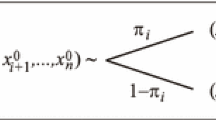Abstract
We study in this paper a non-utilitarian discrete choice model for preference aggregation. Unlike the Plackett-Luce model, this model is not based on the assignment of utility values to alternatives, but on probabilities \(p_i\) to choose the best alternative (according to a ground truth ranking \(r^*\)) in a subset of i alternatives. We consider \(k\!-\!1\) parameters \(p_i\) (for \(i\!=\!2\) to k) in the model, where k is bounded by the number m of alternatives. We study the application of this model to voting, where we assume that the input is a set of choice functions provided by voters. If \(k\!=\!2\), our model amounts to the model used by Young [25] in his statistical analysis of Condorcet’s voting method, and a maximum likelihood ranking is a consensus ranking for the Kemeny rule [12]. If \(k\!>\!2\), we show that, under some restrictive assumptions about probabilities \(p_i\), the maximum likelihood ranking is a consensus ranking for the k-wise Kemeny rule [10]. In the general case, we provide a characterization result for the maximum likelihood ranking r and probabilities \(p_i\). We propose an exact and a heuristic algorithm to compute both ranking r and probabilities \(p_i\). Numerical tests are presented to assess the efficiency of these algorithms, and measure the model fitness on synthetic and real data.
Access this chapter
Tax calculation will be finalised at checkout
Purchases are for personal use only
Similar content being viewed by others
Notes
- 1.
Note that this assumption allows the preferences to be cyclic.
- 2.
When the votes are viewed as noisy perceptions of a ground truth ranking \(r^*\), a noise model is the mathematical description of the probabilities of the votes based on \(r^*\).
- 3.
From now on, we use indifferently \(\overrightarrow{p}\) or \(\overrightarrow{\alpha }\), because one vector can be inferred from the other.
- 4.
All algorithms have been implemented in C++, and the tests have been carried out on an Intel Core I5-8250 1.6 GHz processor with 8 GB of RAM.
References
Aleskerov, F.: Arrovian Aggregation Models. Kluwer Academic (1999)
Arrow, K.J.: Social Choice and Individual Values (1951)
Baldiga, K.A., Green, J.R.: Assent-maximizing social choice. Soc. Choice Welfare 40(2), 439–460 (2013). https://doi.org/10.1007/s00355-011-0614-6
Caragiannis, I., Procaccia, A.D., Shah, N.: When do noisy votes reveal the truth? ACM Trans. Econ. Comput. (TEAC) 4(3), 1–30 (2016)
Conitzer, V., Rognlie, M., **a, L.: Preference functions that score rankings and maximum likelihood estimation. In: IJCAI, pp. 109–115 (2009)
Conitzer, V., Sandholm, T.: Common voting rules as maximum likelihood estimators. In: Proceedings of UAI 2005, pp. 145–152 (2005)
Cormack, G.V., Clarke, C.L., Buettcher, S.: Reciprocal rank fusion outperforms condorcet and individual rank learning methods. In: SIGIR, pp. 758–759 (2009)
Drissi-Bakhkhat, M., Truchon, M.: Maximum likelihood approach to vote aggregation with variable probabilities. Soc. Choice Welfare 23(2), 161–185 (2004). https://doi.org/10.1007/s00355-003-0242-x
Ehrgott, M.: Multicriteria Optimization, vol. 491. Springer (2005). https://doi.org/10.1007/3-540-27659-9
Gilbert, H., Portoleau, T., Spanjaard, O.: Beyond pairwise comparisons in social choice: a setwise Kemeny aggregation problem. In: AAAI, pp. 1982–1989 (2020)
Kamishima, T.: Nantonac collaborative filtering: recommendation based on order responses. In: SIGKDD, pp. 583–588 (2003)
Kemeny, J.G.: Mathematics without numbers. Daedalus 88(4), 577–591 (1959)
Lu, T., Boutilier, C.: The unavailable candidate model: a decision-theoretic view of social choice. In: Proceedings of EC 2010, pp. 263–274 (2010)
Luce, R.D.: Individual Choice Behavior: A Theoretical analysis. Wiley (1959)
Mallows, C.L.: Non-null ranking models. I. Biometrika 44(1/2), 114–130 (1957)
Mattei, N., Walsh, T.: Preflib: a library of preference data http://preflib.org. In: ADT 2013, Lecture Notes in Artificial Intelligence, Springer (2013). https://doi.org/10.1007/978-3-642-41575-3_20
Pennock, D.M., Horvitz, E., Giles, C.L., et al.: Social choice theory and recommender systems: analysis of the axiomatic foundations of collaborative filtering. In: AAAI/IAAI, pp. 729–734 (2000)
Plackett, R.L.: The analysis of permutations. Appl. Stat. 24(2), 193–202 (1975)
Przybylski, A., Klamroth, K., Lacour, R.: A simple and efficient dichotomic search algorithm for multi-objective mixed integer linear programs. ar**v (2019)
Raman, K., Joachims, T.: Methods for ordinal peer grading. In: SIGKDD, pp. 1037–1046 (2014)
Schwarz, G.: Estimating the dimension of a model. Ann. Stat. 461–464 (1978)
Sen, A.: The possibility of social choice. Am. Eco. Rev. 89(3), 349–378 (1999)
Soufiani, H.A., Parkes, D.C., **a, L.: Random utility theory for social choice. In: NeurIPS, pp. 126–134, NIPS 2012, Curran Associates Inc. (2012)
**a, L.: Learning and decision-making from rank data. Synth. Lect. Artif. Intell. Mach. Learn. 13(1), 1–159 (2019)
Young, H.P.: Condorcet’s theory of voting. Am. Polit. Sci. Rev. 82(4), 1231–1244 (1988)
Acknowledgements
We acknowledge a financial support from the project THEMIS ANR20-CE23-0018 of the French National Research Agency (ANR).
Author information
Authors and Affiliations
Corresponding author
Editor information
Editors and Affiliations
Rights and permissions
Copyright information
© 2022 The Author(s), under exclusive license to Springer Nature Switzerland AG
About this paper
Cite this paper
Durand, M., Pascual, F., Spanjaard, O. (2022). A Non-utilitarian Discrete Choice Model for Preference Aggregation. In: Dupin de Saint-Cyr, F., Öztürk-Escoffier, M., Potyka, N. (eds) Scalable Uncertainty Management. SUM 2022. Lecture Notes in Computer Science(), vol 13562. Springer, Cham. https://doi.org/10.1007/978-3-031-18843-5_11
Download citation
DOI: https://doi.org/10.1007/978-3-031-18843-5_11
Published:
Publisher Name: Springer, Cham
Print ISBN: 978-3-031-18842-8
Online ISBN: 978-3-031-18843-5
eBook Packages: Computer ScienceComputer Science (R0)




